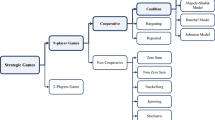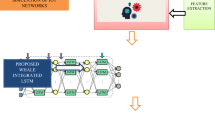Abstract
Our world is rapidly evolving toward the Internet of Things (IoT), that connects all gadgets to digital services and simplifies our lives. As IoT devices expand, network vulnerabilities may rise, leading to more network threats. An intrusion detection system (IDS) with low latency and high accuracy is essential in this dynamic IoT environment to identify threats. Many IDSs utilize deep learning (DL) methods, but adjusting parameters for different environments can be challenging. This work proposes an improved hybrid Deep autoencoder (DAE) and Bidirectional long short-term memory (BiLSTM) for fog item installation to protect vital networks from prompt and efficient malicious threat detection. Determining the hyperparameters of complicated DL networks is tough. Low accuracy, efficiency, and performance in high-dimensional models afflict existing approaches. Therefore, the Sparrow Search Optimization Algorithm (SSOA) is adopted to enhance model hyperparameters. Employing IoT-based data, we assess the effectiveness of our suggested model. The outcome of the experiment obtained by analyzing the suggested IDS utilizing CICIDS2017 and BoT-IoT datasets attested to their supremacy over modern systems that are currently available in terms of precision, accuracy, FAR, error rate, and detection rate (DR). To learn more about how well our model works, added two additional metrics: Cohen's Kappa coefficients and Mathew correlation. The proposed optimization model demonstrated its ability to work well with various platforms, adapt to changing requirements, and handle larger workloads. In addition, it is possible to enhance the intrusion detection rate by minimizing both the error rate and computational time. Based on the experiments conducted, the proposed method yields superior results in terms of detection accuracy and reduced latency.




















Similar content being viewed by others
Data availability
Data’s collected from IOT-FOGCICIDS2017-https://www.unb.ca/cic/datasets/ids-2017.html, Bot-Iot datasets-https://research.unsw.edu.au/projects/bot-iot-dataset
References
Rani M, Gagandeep (2022) Effective network intrusion detection by addressing class imbalance with deep neural networks multimedia tools and applications. Multimed Tools Applic 81(6):8499–8518
Samy A, Yu H, Zhang H (2020) Fog-based attack detection framework for internet of things using deep learning. IEEE Access 8:74571–74585
Hazman C, Guezzaz A, Benkirane S, Azrour M (2023) Toward an intrusion detection model for IoT-based smart environments. Multimed Tools Applic 1–22. https://doi.org/10.1007/s11042-023-16436-0
Vinayakumar, Ravi et al (2019) Deep learning approach for intelligent intrusion detection system. IEEE Access 7:41525–41550
Pustokhina IV, Pustokhin DA, Lydia EL, Garg P, Kadian A, Shankar K (2022) Hyperparameter search based convolution neural network with Bi-LSTM model for intrusion detection system in multimedia big data environment. Multimed Tools Applic 81(24):34951–34968
Kaja N, Shaout A, Ma D (2019) An intelligent intrusion detection system. Appl Intell 49:3235–3247
Chowdhury R, Sen S, Roy A, Saha B (2022) An optimal feature based network intrusion detection system using bagging ensemble method for real-time traffic analysis. Multimed Tools Applic 81(28):41225–41247
Kasongo SM, Sun Y (2020) A deep learning method with wrapper based feature extraction for wireless intrusion detection system. Comput Secur 92:101752
Hassen HB, Ayari N, Hamdi B (2020) A home hospitalization system based on the Internet of things, Fog computing and cloud computing. Inform Med Unlocked 20:100368
Sofla MS, Kashani MH, Mahdipour E, Mirzaee RF (2022) Towards effective offloading mechanisms in fog computing. Multimed Tools Applic 81(2):1997
Ijaz M et al (2021) Integration and applications of fog computing and cloud computing based on the internet of things for provision of healthcare services at home. Electronics 10(9):1077
Gopi R, Sathiyamoorthi V, Selvakumar S, Manikandan R, Chatterjee P, Jhanjhi NZ, Luhach AK (2021) Enhanced method of ANN based model for detection of DDoS attacks on multimedia internet of things. Multimed Tools Applic 81:26739–26757
Liao S, Wu J, Mumtaz S, Li J, Morello R, Guizani M (2020) Cognitive balance for fog computing resource in internet of things: an edge learning approach. IEEE Trans Mob Comput 21(5):1596–1608
Benrazek A-E et al (2020) An efficient indexing for Internet of Things massive data based on cloud-fog computing. Trans Emerg Telecommun Technol 31(3):e3868
Kebede SD, Tiwari B, Tiwari V, Chandravanshi K (2022) Predictive machine learning-based integrated approach for DDoS detection and prevention. Multimed Tools Applic 81(3):4185–4211
Kumar V, Das AK, Sinha D (2021) UIDS: a unified intrusion detection system for IoT environment. Evol Intel 14(1):47–59
Roy S et al (2022) A lightweight supervised intrusion detection mechanism for IoT networks. Futur Gener Comput Syst 127:276–285
Khan MA et al (2021) A deep learning-based intrusion detection system for mqtt enabled iot. Sensors 21(21):7016
Khan MA, Kim J (2020) Toward developing efficient Conv-AE-based intrusion detection system using heterogeneous dataset. Electronics 9(11):1771
Lee J, Park K (2021) GAN-based imbalanced data intrusion detection system. Pers Ubiquit Comput 25:121–128
Tang C, Luktarhan N, Zhao Y (2020) SAAE-DNN: deep learning method on intrusion detection. Symmetry 12(10):1695
Kunang YN, Nurmaini S, Stiawan D, Suprapto BY (2021) Attack classification of an intrusion detection system using deep learning and hyperparameter optimization. J Inf Secur Applic 58:102804
Sarkar A, Sharma HS, Singh MM (2023) A supervised machine learning-based solution for efficient network intrusion detection using ensemble learning based on hyperparameter optimization. Int J Inf Technol 15(1):423–434
Han H, Kim H, Kim Y (2022) An efficient hyperparameter control method for a network intrusion detection system based on proximal policy optimization. Symmetry 14(1):161
Hamza MA, Hashim AHA, Mohamed HG, Alotaibi SS, Mahgoub H, Mehanna AS, Motwakel A (2022) Hyperparameter tuned deep learning enabled intrusion detection on internet of everything environment. CMC-Comput Mater Continua 73(3):6579–6594
Syed NF, Ge M, Baig Z (2023) Fog-cloud based intrusion detection system using Recurrent Neural Networks and feature selection for IoT networks. Comput Netw 225:109662
Hosseini F, Gharehchopogh FS, Masdari M (2023) MOAEOSCA: an enhanced multi-objective hybrid artificial ecosystem-based optimization with sine cosine algorithm for feature selection in botnet detection in IoT. Multimed Tools Applic 82(9):13369–13399
Mohan M, Tamizhazhagan V, Balaji S (2023) Staked deep ensemble model for intruder behaviour detection and classification in cloud. Multimed Tools Applic 1–32. https://doi.org/10.1007/s11042-023-17677-9
Banaamah AM, Ahmad I (2022) Intrusion detection in IoT using deep learning. Sensors 22(21):8417
Ramkumar MP et al (2022) Intrusion detection using optimized ensemble classification in fog computing paradigm. Knowl-Based Syst 252:109364
Otoum Y, Liu D, Nayak A (2022) DL-IDS: a deep learning–based intrusion detection framework for securing IoT. Trans Emerg Telecommun Technol 33(3):e3803
Labiod Y, Amara Korba A, Ghoualmi N (2022) Fog computing-based intrusion detection architecture to protect iot networks. Wirel Pers Commun 125(1):231–259
De Souza CA, Westphall CB, Machado RB (2022) Two-step ensemble approach for intrusion detection and identification in IoT and fog computing environments. Comput Electr Eng 98:107694
Reddy DK, Kumar et al (2021) Exact greedy algorithm based split finding approach for intrusion detection in fog-enabled IoT environment. J Inf Secur Applic 60:102866
Kumar P, Gupta GP, Tripathi R (2021) A distributed ensemble design based intrusion detection system using fog computing to protect the internet of things networks. J Ambient Intell Humaniz Comput 12(10):9555–9572
Zeeshan M et al (2021) Protocol-based deep intrusion detection for dos and ddos attacks using unsw-nb15 and bot-iot data-sets. IEEE Access 10:2269–2283
Sadaf K, Sultana J (2020) Intrusion detection based on autoencoder and isolation forest in fog computing. IEEE Access 8:167059–167068
Samy A, Haining Yu, Zhang H (2020) Fog-based attack detection framework for internet of things using deep learning. IEEE Access 8:74571–74585
Pacheco J et al (2020) Artificial neural networks-based intrusion detection system for internet of things fog nodes. IEEE Access 8:73907–73918
Stiawan D et al (2020) CICIDS-2017 dataset feature analysis with information gain for anomaly detection. IEEE Access 8:132911–132921
Shafiq M, Tian Z, Bashir AK, Du X, Guizani M (2020) CorrAUC: a malicious bot-IoT traffic detection method in IoT network using machine-learning techniques. IEEE Internet Things J 8(5):3242–3254
Koroniotis N et al (2019) Towards the development of realistic botnet dataset in the internet of things for network forensic analytics: bot-iot dataset. Futur Gener Comput Syst 100:779–796
Dua M (2020) Attribute selection and ensemble classifier based novel approach to intrusion detection system. Procedia Comput Sci 167:2191–2199
Lore KG, Akintayo A, Sarkar S (2017) LLNet: a deep autoencoder approach to natural low-light image enhancement. Pattern Recogn 61:650–662
Xue J, Shen B (2020) A novel swarm intelligence optimization approach: sparrow search algorithm. Syst Sci Control Eng 8(1):22–34
Halbouni A, Gunawan TS, Habaebi MH, Halbouni M, Kartiwi M, Ahmad R (2022) CNN-LSTM: hybrid deep neural network for network intrusion detection system. IEEE Access 10:99837–99849
Chen Y, Lin Q, Wei W, Ji J, Wong KC, Coello CAC (2022) Intrusion detection using multi-objective evolutionary convolutional neural network for Internet of things in Fog computing. Knowl-Based Syst 244:108505
Oboya WM, Gichuhi AW, Wanjoya A (2023) A Hybrid DNN-RBFNN model for intrusion detection system. J Data Anal Inf Process 11(04):371–387
Boukhalfa A, Abdellaoui A, Hmina N, Chaoui H (2020) LSTM deep learning method for network intrusion detection system. Int J Electr Comput Eng 10(3):3315
Li Q, Li B, Wen L (2023) An intrusion detection model based on feature selection and improved one-dimensional convolutional neural network. Int J Distrib Sens Netw 2023:1982173. https://doi.org/10.1155/2023/1982173
NG BA, Selvakumar S (2020) Anomaly detection framework for Internet of things traffic using vector convolutional deep learning approach in fog environment. Futur Gener Comput Syst 113:255–265
Babić I, Miljković A, Čabarkapa M, Nikolić V, Đorđević A, Ranđelović M, Ranđelović D (2021) Triple modular redundancy optimization for threshold determination in intrusion detection systems. Symmetry 13(4):557
Jayalaxmi PLS, Kumar G, Saha R, Conti M, Kim TH, Thomas R (2022) DeBot: A deep learning-based model for bot detection in industrial internet-of-things. Comput Electr Eng 102:108214
Zhao G, Wang Y, Wang J (2023) Lightweight intrusion detection model of the internet of things with hybrid cloud-fog computing. Secur Commun Netw 2023:7107663. https://doi.org/10.1155/2023/7107663
Alzubi OA, Alzubi JA, Alazab M, Alrabea A, Awajan A, Qiqieh I (2022) Optimized machine learning-based intrusion detection system for fog and edge computing environment. Electronics 11(19):3007
Funding
This study is supported via funding from Prince Satam bin Abdulaziz University project number (PSAU/2024/R/1445).
Author information
Authors and Affiliations
Corresponding author
Ethics declarations
Conflict of interest
On behalf of all authors the corresponding author declares there is no conflict of Interest.
Additional information
Publisher's Note
Springer Nature remains neutral with regard to jurisdictional claims in published maps and institutional affiliations.
Rights and permissions
Springer Nature or its licensor (e.g. a society or other partner) holds exclusive rights to this article under a publishing agreement with the author(s) or other rightsholder(s); author self-archiving of the accepted manuscript version of this article is solely governed by the terms of such publishing agreement and applicable law.
About this article
Cite this article
Alqahtani, A. Optimized deep autoencoder and BiLSTM for intrusion detection in IoTs-Fog computing. Multimed Tools Appl (2024). https://doi.org/10.1007/s11042-024-18919-0
Received:
Revised:
Accepted:
Published:
DOI: https://doi.org/10.1007/s11042-024-18919-0




